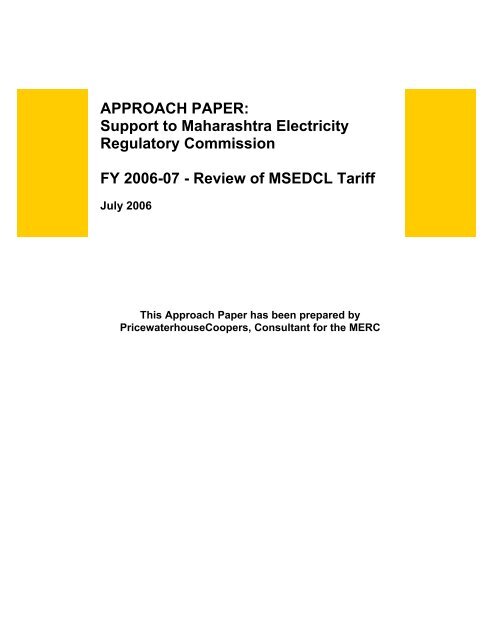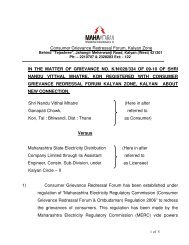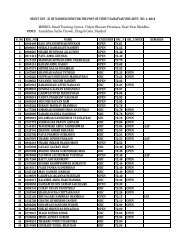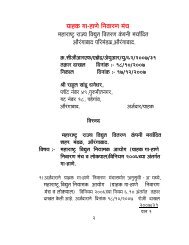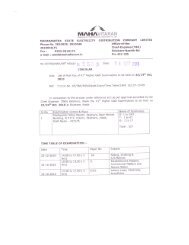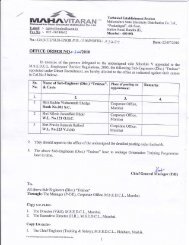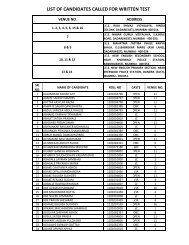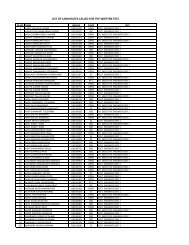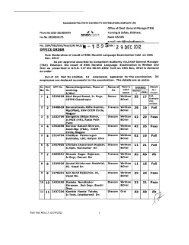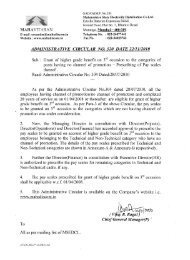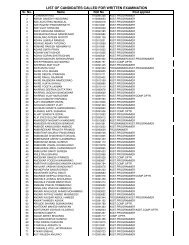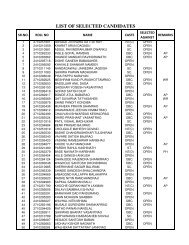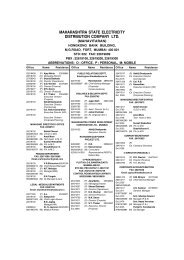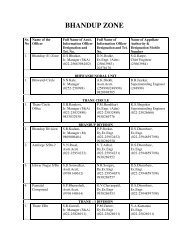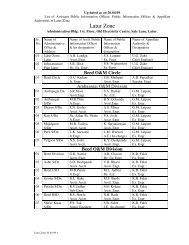APPROACH PAPER: Support to Maharashtra ... - MAHADISCOM
APPROACH PAPER: Support to Maharashtra ... - MAHADISCOM
APPROACH PAPER: Support to Maharashtra ... - MAHADISCOM
You also want an ePaper? Increase the reach of your titles
YUMPU automatically turns print PDFs into web optimized ePapers that Google loves.
<strong>APPROACH</strong> <strong>PAPER</strong>2006-07 MSEDCL TARIFF REVIEWContentsA1: INTRODUCTION .....................................................................................................................................3A2: FACTUAL TARIFF INCREASE............................................................................................................4A3: IMPLEMENTATION OF WILLINGNESS TO PAY..........................................................................6SCENARIO 1............................................................................................................................................................7SCENARIO 2............................................................................................................................................................9SCENARIO 3..........................................................................................................................................................10A4: DETERMINATION OF WHEELING CHARGES ............................................................................12PricewaterhouseCoopers Page 2July 2006
<strong>APPROACH</strong> <strong>PAPER</strong>2006-07 MSEDCL TARIFF REVIEWA1: INTRODUCTION1.1 <strong>Maharashtra</strong> Electricity Regula<strong>to</strong>ry Commission (hereinafter referred as “theCommission”) has issued three (FY 2001, FY 2002 and FY 2004) Tariff Orders forthe erstwhile <strong>Maharashtra</strong> State Electricity Board (MSEB).1.2 With the enactment and <strong>to</strong> achieve the objectives of Electricity Act 2003 (hereinafterreferred as “Act”), Government of <strong>Maharashtra</strong> (GoM) vide its GR dated January 24 th2005 with effect from June 6 th 2005 has restructured the erstwhile MSEB in<strong>to</strong> fourcompanies namely MSEB Holding Company, <strong>Maharashtra</strong> State Power GenerationCompany Ltd (MSPGCL - MahaGenco), <strong>Maharashtra</strong> State Electricity TransmissionCompany Ltd (MSETCL - MahaTransco) and <strong>Maharashtra</strong> State ElectricityDistribution Company Ltd.(MSEDCL - MahaDiscom).1.3 MSEDCL in the capacity of distribution and retail supply licensee has filed forAggregate Revenue Requirement (ARR) and Tariff Petition on February 28 th 2006and May 26 th 2006 respectively as per Section 61, 62 and 64 of the Act and as per theMERC (Terms and Conditions of Tariff), 2005 for FY 2006-07. In the Tariff Petition,MSEDCL has also made certain modifications <strong>to</strong> the ARR. The utility projectedrevenue gap of about Rs 5462 Crores and proposed an average tariff increase of28.8% <strong>to</strong> meet the revenue gap.1.4 The Commission has appointed PricewaterhouseCoopers (PwC) as the consultants forreview of MSEDCL’s ARR and Tariff filings. From the preliminary review of thefilings, it was found that some of the key issues have not been emphasised byMSEDCL accurately in the tariff application despite the serious impact that theseissues have on consumers, quality of supply and tariffs. Hence it was felt appropriate<strong>to</strong> circulate an approach paper highlighting the key issues for public consultation. Thekey issues include(a)(b)(c)Factual increase in Retail Supply TariffsImplementation of “willingness <strong>to</strong> pay” conceptDetermination of wheeling charges1.5 PwC is involved in reviewing the ARR and Tariff petition, for the purpose ofapproach note it has limited the source of information <strong>to</strong> the filed numbers instead ofreview numbers, as a result, PwC has mostly used the information (includingadditional information) filed by MSEDCL as part of FY 2006-07 tariff review. Thiswill also facilitate the public <strong>to</strong> relate the information submitted in the filings. Theanalysis presented in the document is only <strong>to</strong> facilitate better understanding of theissues and is prepared for general guidance on matters of interest only.PricewaterhouseCoopers Page 3July 2006
<strong>APPROACH</strong> <strong>PAPER</strong>2006-07 MSEDCL TARIFF REVIEWA2: FACTUAL TARIFF INCREASE2.1 In the tariff petition, MSEDCL has projected a revenue gap of Rs. 5462 Crore for FY2006-07 based on the aggregate revenue requirement projections and revenue fromexisting tariffs. For computing the revenue gap, MSEDCL has also included thefinancial losses pertaining <strong>to</strong> the previous years of FY 2004-05 and FY 2005-06.MSEDCL has included financial loss of Rs 513 Crores for FY 2005 and Rs 1401Crores for FY 2006. The consolidated gap for FY 2005, FY 2006 and FY 2007 whichMSEDCL intend <strong>to</strong> recover from tariff increase is Rs 5462 Crores.2.2 For FY 2006-07, MSEDCL has projected the revenue from existing tariff includingRegula<strong>to</strong>ry Liability charges at Rs. 18942 Crores. Based on the existing tariff revenueestimates and the revenue gap, MSEDCL has proposed an average tariff increase of28.8%. This tariff increase would result in increasing the revenues from Rs 18,942Crores <strong>to</strong> Rs 24,405 Crores and thereby addressing the entire revenue gap. The detailsare presented below:Particulars Rs/ Kwh Revenue(Rs Crores)Revenue at existing tariffs as proposed byMSEDCL3.56 1 18,942Revenue from the proposed tariff 4.58 24,405Average Increase In Tariff Proposed 28.8%2.3 In their representation, MSEDCL have combined the regula<strong>to</strong>ry liability charges (50ps / unit) and fuel adjustment charges (96ps/unit) <strong>to</strong> the existing energy tariffs. WhileRLC is a constant tariff charged by MSEDCL <strong>to</strong> the subsidising consumers, the FACcharge is not a constant tariff and it depends on the fuel cost variations for a particularmonth or quarter, etc.2.4 The Commission has approved FAC of 96 ps / unit only for the month of February’06where as MSEDCL has combined the FAC with the existing energy tariffs andapplied the same for the entire year of FY 2006-07. The average FAC approved by theCommission in FY 2005-06 has been 49 paisa/kWh and hence it would be appropriate<strong>to</strong> assume 49 ps / unit as part of existing tariffs instead of 96 ps /unit. With thiscorrection in the existing energy tariff, the average tariff increase required would be43% and not 28.8% as presented by MSEDCL.1 Rs 3.56 per unit is the average realization for MSEDCL as a whole i.e. revenue from all category of consumersdivided by sales <strong>to</strong> all category of consumersPricewaterhouseCoopers Page 4July 2006
<strong>APPROACH</strong> <strong>PAPER</strong>2006-07 MSEDCL TARIFF REVIEWA3: IMPLEMENTATION OF WILLINGNESS TO PAY3.1 The average cost of supply has increased from Rs 3.07 per unit in FY 2003-04 tarifforder <strong>to</strong> Rs 4.58 per unit in FY 2006-07 petition of MSEDCL. The utility hasproposed tariff increase of 43% (factual tariff increase) from the consumers. One ofthe significant reasons for such cost and tariff increases is the dependence ofMSEDCL on costly power generating stations viz. traded power, RGPPL etc <strong>to</strong>address the load deficit situation in the state.3.2 It is felt appropriate that the consumers should be aware of the implications ofsupplying quality power i.e. with reduced or no load shedding. Currently, MSEDCLfaces a demand supply gap with the present capacity available from State generationand Central generating stations. To address this deficit, MSEDCL is sourcing powerfrom traders and other costly generating stations thereby increasing the cost of supplyand tariff increase required.3.3 From the interactions with different consumer organisations it was unders<strong>to</strong>od that allthe consumers would not be willing <strong>to</strong> pay for reduction in load shedding and henceonly those consumers who are willing <strong>to</strong> pay for reduced load shedding have <strong>to</strong> besubjected <strong>to</strong> such purchase cost and tariff increases. National Tariff Policy alsospecifies that consumers, particularly those who are ready <strong>to</strong> pay a tariff whichreflects efficient costs have the right <strong>to</strong> get uninterrupted 24 hours supply of qualitypower.3.4 Recently, the Commission has conceptualised and applied the principle of“willingness <strong>to</strong> pay” for supply of uninterrupted power in Pune urban circles withsupport from MSEDCL and Confederation of Indian Industry (CII). To understand theimplications of purchase from costly sources, few scenarios have been presentedhighlighting the impact of additional power purchase on reduction in hours of loadshedding and tariff increase required. These are indicative results and are based on thedata submitted by the licensee.3.5 The Commission has stipulated load shedding pro<strong>to</strong>col, wherein the divisions arecategorized as urban and industrial agglomerations, agricultural dominated regions,and other regions, and classified as A, B, C or D group, depending on the distributionand collection loss in the division. The grouping is presented below:PricewaterhouseCoopers Page 6July 2006
<strong>APPROACH</strong> <strong>PAPER</strong>2006-07 MSEDCL TARIFF REVIEWGroupWeighted average loss and collectionefficiency levelUrbanRural1 Group A 0% <strong>to</strong> 25% 0% <strong>to</strong> 28%2 Group B > 25% <strong>to</strong> 35% > 28% <strong>to</strong> 38%3 Group C > 35% <strong>to</strong> 50% > 38% <strong>to</strong> 53%4 Group D Above 50% Above 53%3.6 Commission in its order in the matter of Revision in the Principles and Pro<strong>to</strong>col forLoad Shedding by MSEDCL dated 10 Jan 2006 has also revised the Load sheddingpro<strong>to</strong>col for a demand-supply gap level of 4500 MW as follows.Region Urban &industrialAgglomerationsOtherRegionsAgriculturedominatedregionsAnticipatedLoad Reliefin EveningPeak HoursGroup Hours Hours Hours MWA 2.5 4.5 11.0B 3.0 5.0 11.5C 3.5 5.5 12.0D 4.0 6.0 12.04000-45003.7 The scenarios are based on the above groupings and the load shedding pro<strong>to</strong>colsdiscussed.Scenario 13.8 This scenario is the base case scenario where MSEDCL’s power purchase includesthe costly power acquired from RGPPL, traders etc. This scenario is as per the presentfiling where in MSEDCL has assumed purchases from costly stations <strong>to</strong> reduce theload shedding hours.3.9 The amount of Load Shedding for Scenario 1 as per the pro<strong>to</strong>col in the months ofOc<strong>to</strong>ber’06 and December’06 is as follows. Two months load shedding informationhas been provided <strong>to</strong> demonstrate that there would be change in the load sheddinghours based on the actual demand of the system.PricewaterhouseCoopers Page 7July 2006
<strong>APPROACH</strong> <strong>PAPER</strong>2006-07 MSEDCL TARIFF REVIEWMonth Region Urban &industrialAgglomerationsOct’06Dec’ 06Other RegionsAgriculturedominatedregionsA 2.25 4.25 7.50B 2.75 4.75 8.00C 3.25 5.25 8.50D 3.75 5.75 9.00A 2.50 4.50 11.00B 3.00 5.00 11.50C 3.50 5.50 12.00D 4.00 6.00 12.003.10 In this scenario, the hours of load shedding ranges from 2.25 hours <strong>to</strong> 12 hours basedon the group and category that the division belongs <strong>to</strong>. The maximum load sheddingis for D category agricultural dominated region, at 12 hours daily, while the least loadshedding is for A category urban and industrial agglomerations, at 2.5 hours per day.3.11 The tariff impact of the Scenario 1 has been presented in the following table.Scenario 1 (2006-07) 2006-07Revenue Gap(CorrectedTariff)ARR (In Rs. Cr) 24405Projected Sales 53,254Revenue from Existing Tariff (In Rs.Cr) 18942 17050Cumulative Revenue Gap (In Rs. Cr) 5462 7355WithcostlypowerExisting tariff Existing Tariff(as filed) (Corrected)New tariffAverage Tariff for MSEDCL 3.56 3.20 4.58Percentage Inc/Dec in Tariffs fromexisting tariffs (as Filed) 28.8%Percentage Inc/Dec in tariffs fromexisting (corrected) tariffs 43%3.12 From the above table it is evident that <strong>to</strong> meet the increased costs, especiallypurchases from costly sources, MSEDCL requires an overall tariff increase of 43%.PricewaterhouseCoopers Page 8July 2006
<strong>APPROACH</strong> <strong>PAPER</strong>2006-07 MSEDCL TARIFF REVIEWScenario 23.13 This scenario assumes that MSEDCL does not purchase any power from the costlysources such as RGPPL, traders etc. Given below are the Load Shedding details incase power is not procured from the costly sources.Month Region Urban &industrialAgglomerationsOCT.06Dec 06Other RegionsAgriculturedominatedregionsA 4.00 6.00 12.50B 4.50 6.50 13.00C 5.00 7.00 13.50D 5.50 7.50 13.50A 6.50 9.00 15.50B 7.00 9.50 16.00C 7.50 10.00 16.50D 8.00 10.50 16.503.14 The Load shedding hours have been increased due <strong>to</strong> effect of non-procurement ofpower from the costly sources. Load shedding which was in the range of 2.25-12 hrswhen power was purchased from costly sources has gone up <strong>to</strong> the range of 4.00 –16.50 hrs across the different categories mentioned.3.15 In this scenario, the load shedding hours would exceed the ceiling limit of 12 hoursspecified by the Commission.3.16 The tariff impact of scenario 2 is presented in the following table.PricewaterhouseCoopers Page 9July 2006
<strong>APPROACH</strong> <strong>PAPER</strong>2006-07 MSEDCL TARIFF REVIEWScenario 2 (2006-07) Filed Tariff CorrectedTariffARR (In Rs. Cr) 20312 20312Revised Projected Sales 47,497 47,497Total Revenue from Sales(Without Costly Power) - 17236 15472Revenue Gap (In Rs. Cr) 3077 4840Withoutcostly power3.17 In Scenario 2, as MSEDCL would not be procuring the additional power from costlysources there would be reduction in the power purchase cost. There shall be reductionin the revenue also as the sales for the categories would reduce based on the revisedload shedding requirement. The net impact of not purchasing from costly sourceswould be a tariff increase of 31% instead of 43%.3.18 From the analysis of Scenario 1 and 2 it can be interpreted that <strong>to</strong> avoid extra loadshedding of 1.75-4.5 hours the consumers have <strong>to</strong> pay higher tariffs <strong>to</strong> the extent ofadditional 12% tariff hike.Scenario 3New TariffAverage Tariff for MSEDCL 4.28Percentage Inc/Dec in Tariffsfrom existing tariffs (as Filed) 18%Percentage Inc/Dec in tariffsfrom existing (corrected) tariffs 31%3.19 In Scenario 1 and Scenario 2, the costly power purchase is allocated <strong>to</strong> all theconsumer categories in the state. In Scenario 3, it is assumed that the costly powerpurchase from Traders and RGPPL would be reserved for the urban and industrialagglomerations that may be willing <strong>to</strong> pay a higher rate for assurance of uninterruptedpower. The following table presents the financial implications of reducing oreliminating the load shedding hours for the urban and industrial agglomerations.PricewaterhouseCoopers Page 10July 2006
<strong>APPROACH</strong> <strong>PAPER</strong>2006-07 MSEDCL TARIFF REVIEWParticularsAurangabadThane Vashi Nagpur NashikDaily load requirement <strong>to</strong>avoid load shedding (MU)Monthly load requirement(MU)Cost of additional powerprocurement (Crores)Indicative Tariff impact perunit Rs/unit0.69 2.42 0.98 1.16 0.6320.58 72.45 29.40 34.86 18.908.93 31.44 12.76 15.13 8.201.34 2.08 0.57 1.56 1.043.20 The tariff impact indicated in the above table is over and above the energy tariff andthis charge is only <strong>to</strong> ensure uninterrupted power supply <strong>to</strong> urban and industrialagglomerations if they are willing <strong>to</strong> pay for such power.3.21 For costing the additional power procurement for the urban and industrialagglomerations, an average rate of power purchased from traders and RGPPL whichis about Rs 4.34 per unit has been adopted. The above financial implication table is <strong>to</strong>eliminate the load shedding of 7 hours. If uniformity principles are adopted for all theconsumers, then the applicable load shedding hours would be in the range of 5 hours<strong>to</strong> 8 hours. For the analysis, 7 hours load shedding has been used. The tariff impactwould be further increased on account of adjustment for losses.PricewaterhouseCoopers Page 11July 2006
<strong>APPROACH</strong> <strong>PAPER</strong>2006-07 MSEDCL TARIFF REVIEWA4: DETERMINATION OF WHEELING CHARGES4.1 Section 62 of the Electricity Act requires State Electricity Regula<strong>to</strong>ry Commission <strong>to</strong>determine tariffs for Transmission, Wheeling and Retail sale of electricity.4.2 Section 42 of the Act requires the Commission <strong>to</strong> introduce Open Access in a phasedmanner for distribution network and specifies that the duties of the distributionlicensee with respect <strong>to</strong> such supply shall be of a common carrier providing nondiscrimina<strong>to</strong>ryopen access.4.3 Section 9 of the Act requires the captive consumers using distribution network <strong>to</strong> payonly wheeling charges and they are not required <strong>to</strong> pay the cross-subsidy surcharge,implying that the wheeling charges determined must be free from any kind of hiddencross-subsidies.4.4 National Tariff Policy (NTP) notified on 6 th January 2006 specifies in clause 8.5.5,that ‘Wheeling charges should be determined on the basis of same principles as laiddown for intra-state transmission charges and in addition would include average losscompensation of the relevant voltage level’. Clause 7.1(7) on intra-state transmissionpricing specifies that the fac<strong>to</strong>rs <strong>to</strong> be considered are ‘voltage, distance, direction andquantum of flow’.4.5 MERC regulation on Terms and Conditions of Tariff mandates every DistributionLicensee <strong>to</strong> make a separate application for determination of tariff for wheeling andretail sale of electricity. It also provides that every distribution licensee needs <strong>to</strong>maintain separate records for Distribution Business and prepare an AllocationStatement <strong>to</strong> enable the Commission determine the tariff pursuant <strong>to</strong> each suchapplication made by the distribution licensee.4.6 However, MSEDCL has not proposed any tariff for wheeling separately in the ARRand filing petition. Only after the technical validation, MSEDCL has proposed amechanism <strong>to</strong> allocate the costs between wheeling business and retail supply business.Though MSEDCL doesn’t have separate accounts for wheeling and retail supply,separation of wheeling costs and retail supply costs based on certain assumptionswould be required for determination of wheeling charges. The Commission hasalready issued the open access phasing regulations and for effective implementationof open access a separate cost based wheeling charge would be required.PricewaterhouseCoopers Page 12July 2006
<strong>APPROACH</strong> <strong>PAPER</strong>2006-07 MSEDCL TARIFF REVIEW4.7 In case a consumer opts <strong>to</strong> take supply from a person other than MSEDCL throughopen access, the consumer has <strong>to</strong> pay wheeling charges <strong>to</strong> MSEDCL for use ofnetwork. The consumer opting for an alternate supply through open access shall usethe network of MSEDCL <strong>to</strong> wheel the power procured and hence has <strong>to</strong> pay the costrelated <strong>to</strong> network. At present MSEDCL is managing both distribution wires businessand retail supply business. As the open access consumers would be using only thenetwork assets / service of MSEDCL, he has <strong>to</strong> pay only for such services / assetsthrough the wheeling charges and not required <strong>to</strong> pay for the retail supply costs.Hence, there is a requirement for MSEDCL <strong>to</strong> separate the wheeling costs and retailsupply costs so that wheeling charges would be linked <strong>to</strong> the costs incurred byMSEDCL on network business only.4.8 The following table present the unbundled costs incurred by MSEDCL <strong>to</strong> serve anindustrial consumer say HT 1 consumer.Cost / Tariff particularsRate (Rs/unit)Transmission Cost 0.35Distribution (network) costs 0.57Retail Supply (Power purchase includinglosses plus retail) costs3.67Cross-subsidy 1.45Average Tariff 6.034.9 The above allocation and numbers are only indicative and are based on the averagecost of supply methodology. In case, a voltage based cost methodology or any otheralternate approach is adopted the numbers shall undergo a change. The above table isonly <strong>to</strong> demonstrate the type of costs/tariff incurred/charged by a distribution licensee.From the above table, it is evident that the wheeling cost incurred (based on theaverage cost methodology) by the distribution licensee would be about 57 ps/unit andhence each consumer has <strong>to</strong> pay the same for using the wheeling services ofMSEDCL.4.10 The wheeling services of MSEDCL are not only used by open access consumers butalso all other consumers supplied by MSEDCL i.e. domestic, street lighting,commercial, agriculture, industrial etc. To promote competition the open accesstariffs, terms and conditions need <strong>to</strong> be non-discrimina<strong>to</strong>ry. Non-discrimina<strong>to</strong>ry openaccess tariffs would mean that MSEDCL should charge the same tariff for anyconsumer irrespective of the supplier. The supplier may be MSEDCL itself or acaptive generating station or a generating station / trader / other distribution licensee.PricewaterhouseCoopers Page 13July 2006
<strong>APPROACH</strong> <strong>PAPER</strong>2006-07 MSEDCL TARIFF REVIEW4.11 For effective implementation of non-discrimina<strong>to</strong>ry tariffs it would be required <strong>to</strong>unbundle costs and tariffs.4.12 Consumers or interested parties may have <strong>to</strong> look in<strong>to</strong> the allocation proposed by theutility and come forward with relevant suggestions, comments for determination ofwheeling charges.PricewaterhouseCoopers Page 14July 2006


